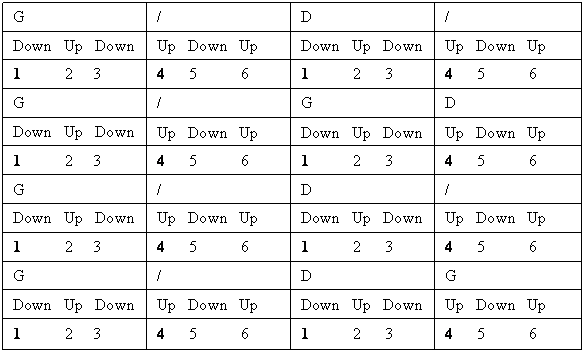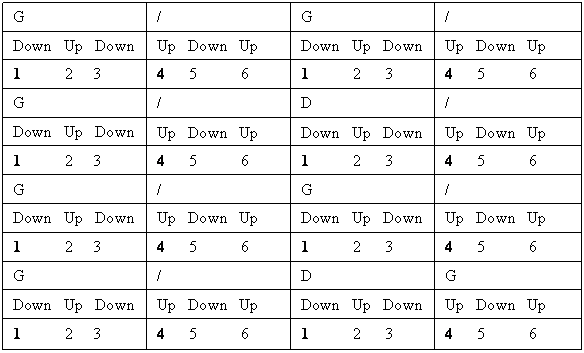|
|
|
The Kesh Jig
Forward to Exercise 2
In this chapter, we will work through a series of exercises to help us in our understanding of how to play the Jig rhythm. Jigs are played in the time signature 6/8 which, for our immediate purposes, means there are 6 beats to every bar counted as 1 2 3 4 5 6, 1 2 3 4 5 6 etc. The following Jig is called The Kesh Jig and, for these exercises, we will only use the chords of G and D.
 
Play the chord of G in Jig time. In the following example, the chord is strummed over two bars using alternate down and up strokes while emphasising the beat on the 1 and the 4. Each bar is played using the count of 1 2 3 4 5 6 where the 1 (down stroke) and the 4 (up stroke) are accentuated. You can emulate this vocally by repeating the phrase Energy / Energy while counting out the beat (Energy on the 1 2 3 and Energy on the 4 5 6). Strum the G chord across the full six strings on both the down and up strokes counting 6 beats in the bar (6 in a Bar).
6 in a Bar - G Chord
Now that we are able to play the G chord across this rhythm, let us turn our attention to playing the D chord. Apply the same technique across the chord of D.
6 in a Bar - D Chord
In the chord of G, the bass-note falls on the 6th string E, 3rd fret while, in the chord of D, the bass note falls on the 4th string D, open. Therefore, the D chord is played using only the top four strings while the G chord is played using all six strings. Remember the accent falls on beats 1 (down stroke) and 4 (up stroke). In the case of the D chord, this means strumming down from the D (4th string) on the 1 and up to the D string on the 4. The remaining beats are played as short down and up strokes that also need to cover the top four strings that make up the D chord. The same applies to the G chord in that it is strummed down from the bass note on the 1 and strummed up on the 4. It is important to develop this accuracy in your playing as we will regularly come across chords that phrase across different bass strings. Practice this until you are confident enough to create the full sound of each chord using this rhythm. We also need to learn to play these chords across the split bar. Practice the following examples.
Split Bar G to D Split Bar D to G
Split Bar D to G
Play The Kesh Jig once through using this standard 6/8 rhythm.
A Part x 2 B Part x 2
B Part x 2

Practice the changes across the split bars (bar 4 - G to D and bar 8 - D to G) carefully until you are completely familiar with them. The ability to change chords smoothly across a bar of 6/8 rhythm is fundamental to the proper accompaniment of a Jig. Remember that the chords in both these bars change on the 1 (down stroke) and the 4 (up stroke) so it is important to be accurate in your strumming technique and aware that the bass notes of both these chords fall on different strings.
Now that you can strum a standard 6/8 pattern across the above chord structure let us look at some of the ways in which this strum pattern can be modified. Changing the accent in specific bars and introducing a simple bass strum technique into the pattern allows a greater degree of flexibility in the accompaniment of this Jig.
Exercise 2
|
|
|
|